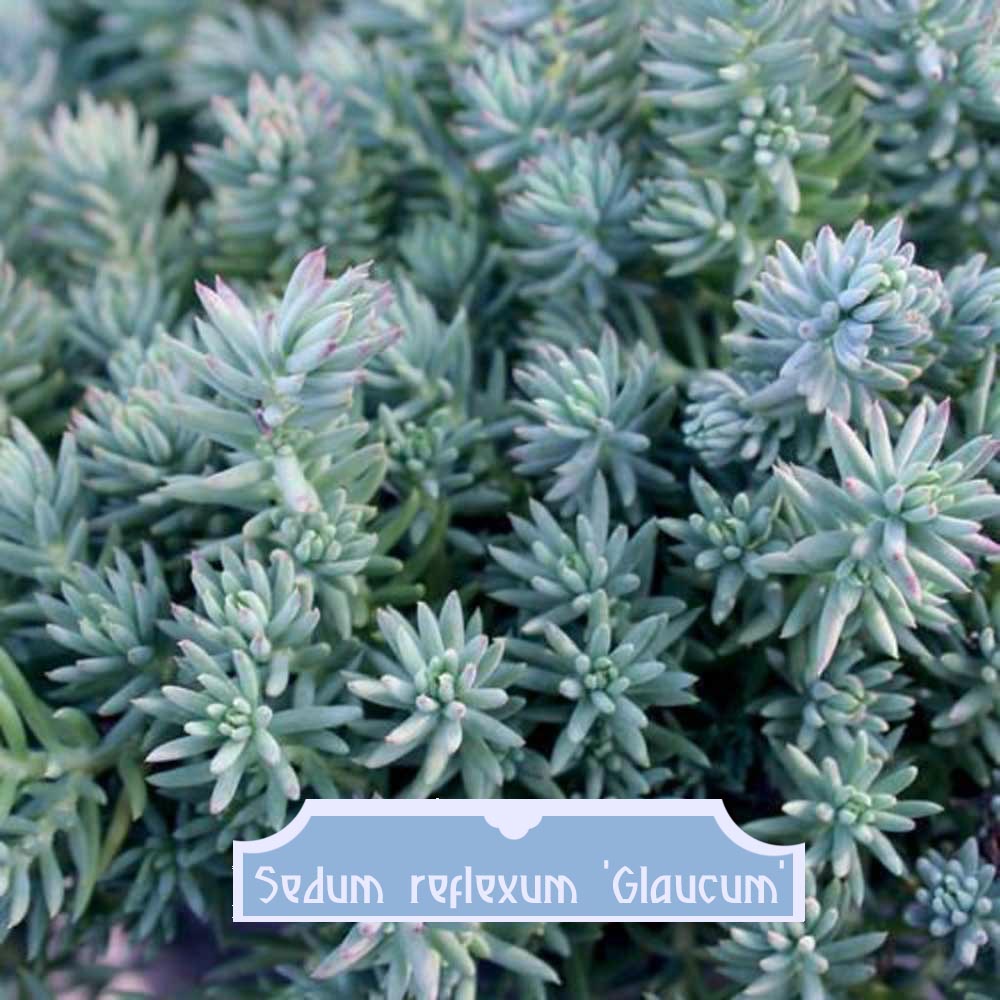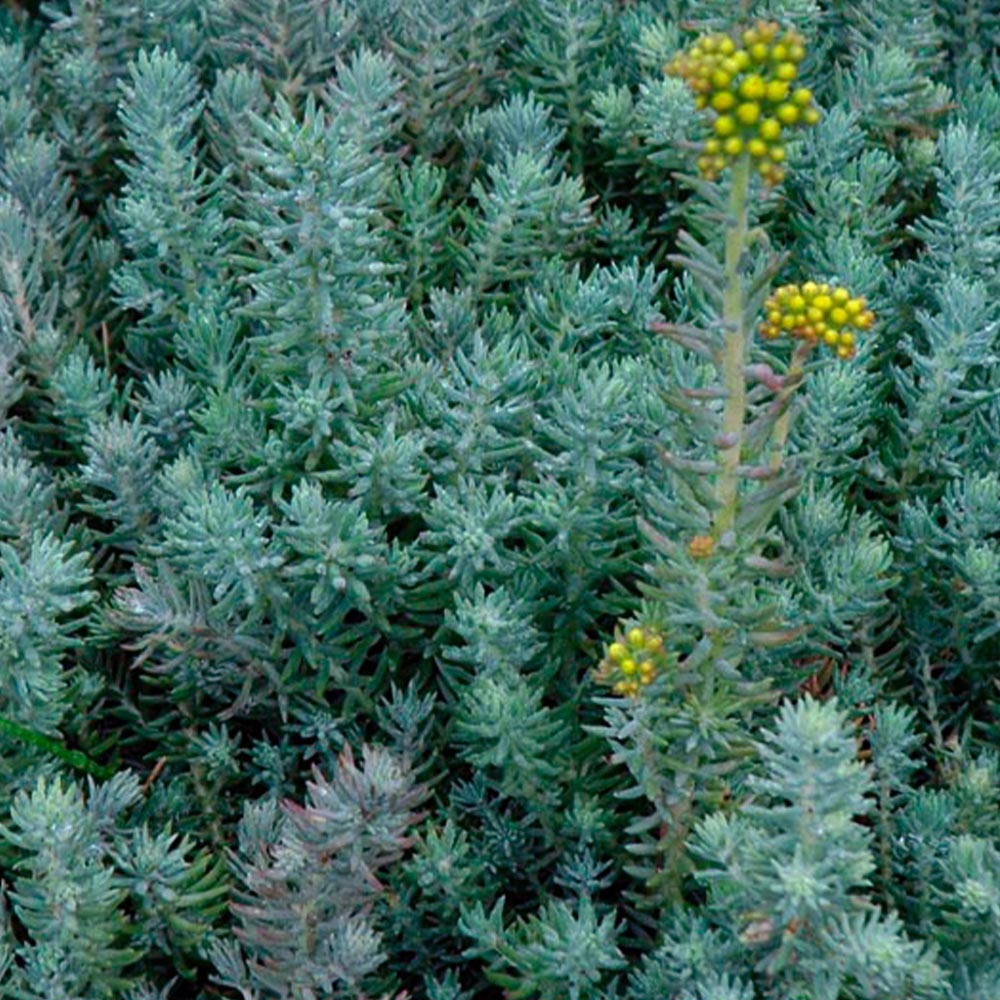No products in the cart.
Sedum reflexum ‘Glaucum’
An elegant blue, low-maintenance perennial ground cover.
Rated 0 out of 5
0 customer reviews
4,90 €
Only 9 item(s) left in stock!
SKU: pda452
Category: Balcony-Friendly, Bees and Butterflies, Bouquet, Evergreen, Frost Hardy, Ground Cover, Make it Pop, Rewild

Sedum reflexum 'Glaucum'
4,90 €
Only 9 item(s) left in stock!
Sedum reflexum ‘Glaucum’ is a low-growing, evergreen succulent prized for its needle-like, blue-gray foliage, which resembles a miniature spruce.
This variety is particularly striking with its fine, gray-green-blue, bristly leaves.
It forms dense, mat-forming rosettes that spread gradually, making it ideal for rock gardens, green roofs, container planting, and groundcover.
In summer, it produces small, star-shaped yellow flowers atop short stems, attracting bees and other pollinators.
Its succulent leaves store water, giving it excellent drought tolerance, while the compact growth habit and striking foliage color add year-round architectural interest.
👨🌾GARDENING TIPS👨🌾:
-
-
Perfect for rock gardens, alpine gardens, container planting, hanging baskets, or mixed succulent displays.
-
Combines beautifully with other Sedum species, Sempervivum, and Crassula for textured succulent arrangements.
-
Minimal maintenance is required, with occasional pruning to maintain shape and remove spent flower stems.
-
Learn more about caring for your Sedum:
The Tales & The Botany: Sedum reflexum ‘Glaucum’
Reflexum vs rupestre – this is an ongoing debate that turns around the inflorescences and which way they face when the buds are produced.
However!
I’ve found in my Sedum journeys – both practical and literary that:
-
- the fine-leaved Sedum rupestre of Dillenius later was classified as Sedum reflexum, then reclassified by Linnaeus as Sedum rupestre var. reflexum named under Linnaeus so… they are.. the same?
- Petrosedum rupestre and Petrosedum forsterianum seem to be clearly derive from the same rupestre taxon but are systematically separated by taxonomists
It’s a bit of a wacky world.
I have found this illustration to be helpful – by Juan Luis Castillo in “Flora iberica” of Castroviejo.

The plant can be seen on ‘green roofs’ or ‘green wall’ systems in Korea where plants are incorporated into the structure of the building, providing habitats for wildlife and innovative insulation solution for humans.
🌸 Floral Morphology: Sedum reflexum ‘Glaucum’
Sedum reflexum ‘Glaucum’ is a low-growing, mat-forming succulent in the Crassulaceae family, with slender, needle-like, glaucous blue-green leaves arranged along trailing stems.
In summer, the plant produces small, star-shaped, yellow flowers clustered in loose inflorescences (cymes).
Flowers are actinomorphic and hermaphroditic, with five sepals and five petals, and a superior ovary.
The fleshy, water-storing leaves give the plant its resilience under drought and help maintain turgor during dry periods.
🧬 Reproductive Biology
Pollination is primarily entomophilous, attracting bees and other small insects. Sedum propagates easily through leaf cuttings or stem offsets, allowing rapid vegetative reproduction.
Seeds are produced in small capsules but vegetative propagation is far more common in cultivation.
The plant exhibits Crassulacean Acid Metabolism (CAM), opening stomata at night to conserve water while allowing photosynthesis during the day.
🦋 Ecology & Cultivation
Sedum thrive in well-drained, sandy or rocky soils under full sun, although it tolerates light shade.
It is drought-tolerant, frost-sensitive, and well-suited for rock gardens, containers, or as ground cover.
The plant is low-maintenance, requires minimal watering, and benefits from occasional pruning to remove damaged or overgrown stems.
Its vibrant leaf colors and compact growth habit make it popular for ornamental gardening and succulent collections.
Other names:
Orange Stonecrop
Orpin Bleu
Origin:
Europe
| Weight | 0,5 kg |
|---|---|
| Flowering | June, July, August |
| Exposure | Full Sun |
| Frost Tolerance | -25°C to -30°C |
| Size | 0.2m H x 0.5m W |
| Soil | Loam, Dry, Sandy, Well-Draining |
Reviews
0
Rated 0 out of 5
0 customer reviews
5
0
4
0
3
0
2
0
1
0
Only logged in customers who have purchased this product may leave a review.
You may also like…
Sedum pachyclados
Dainty green/gray/green succulent with rosettes and a creeping stem that can either spread or cascade.
Dainty green/gray/green succulent with rosettes and a creeping stem that can either spread or cascade.
Rated 0 out of 5
Sedum album
A low, multi-color ground cover.
A low, multi-color ground cover.
Rated 0 out of 5
Related Products
Vinca minor
Looping elegance and ability to form a low flowering ground cover
Looping elegance and ability to form a low flowering ground cover
Rated 0 out of 5
Hellebore argutifolius
Winter flowering perennial with marbled blue-green leaves
Winter flowering perennial with marbled blue-green leaves
Rated 0 out of 5
Euphorbia myrsinites
Known for its draping form of silver-gray foliage and radiant blooms.
Known for its draping form of silver-gray foliage and radiant blooms.
Rated 0 out of 5
Artemisia Valerie Finnis
A semi-evergreen, aromatic variation on the theme of Artemisia.
A semi-evergreen, aromatic variation on the theme of Artemisia.
Rated 0 out of 5
Erigeron kavinskianus
A daisy-like carpet of flowers
A daisy-like carpet of flowers
Rated 0 out of 5
Echinacea purpurea
A perennial with purple flowers all summer long
A perennial with purple flowers all summer long
Rated 0 out of 5
Tradescantia Blushing Bride
Gorgeous blushes of pink and white that appear in the coldest nights.
Gorgeous blushes of pink and white that appear in the coldest nights.
Rated 0 out of 5
Glechoma hederacea
A sweet smelling ground cover, producing little blue flowers all summer long.
A sweet smelling ground cover, producing little blue flowers all summer long.
Rated 0 out of 5
Euphorbia cyparissias Clarice Howard
A Euphorbia that resembles a soft little cyprus tree
A Euphorbia that resembles a soft little cyprus tree
Rated 0 out of 5
Hieracium maculatum Leopard
A native perennial with blue-green leaves and a tall yellow flower
A native perennial with blue-green leaves and a tall yellow flower
Rated 0 out of 5
Mentha x piperita ‘Chartreuse’
A spicy mint, known for its use in the production of liqueurs and herbal teas.
A spicy mint, known for its use in the production of liqueurs and herbal teas.
Rated 0 out of 5
Delosperma cooperi
A dwarf perennial known for its vermillion colored flowers
A dwarf perennial known for its vermillion colored flowers
Rated 0 out of 5
Stachys byzantina
Silky white-grey leaves and tall striking flowers
Silky white-grey leaves and tall striking flowers
Rated 0 out of 5
Melissa officinalis
A perennial plant in the mint family that is adored by bees, royal families and tea drinkers.
A perennial plant in the mint family that is adored by bees, royal families and tea drinkers.
Rated 0 out of 5
Trachelospermum asiaticum ‘Ogon Nishiki’
Jasmine with colorful foliage and lovely white flowers in summer
Jasmine with colorful foliage and lovely white flowers in summer
Rated 0 out of 5
Cerastium tomentosum var. columnae
A grey-green spreading ground cover from the mountains.
A grey-green spreading ground cover from the mountains.
Rated 0 out of 5
Kalanchoe daigremontiana
A toothy succulent from Madagascar, known as the Mother of Thousands.
A toothy succulent from Madagascar, known as the Mother of Thousands.
Rated 0 out of 5
Tanacetum densum subsp amani
A shrublet composed of soft, finely divided silvery gray-white leaves.
A shrublet composed of soft, finely divided silvery gray-white leaves.
Rated 0 out of 5
recent view product
Centranthus ruber Albus
A wonderfully resilient perennial, producing white panicles all summer long.
A wonderfully resilient perennial, producing white panicles all summer long.
Rated 0 out of 5
Sedum kamtschaticum
A multi-colored sedum from the volcanic soils of the Kamchatka Peninsula
A multi-colored sedum from the volcanic soils of the Kamchatka Peninsula
Rated 0 out of 5
Centaurea atropurpurea
A perennial thistle with intensely purplish-red flowers
A perennial thistle with intensely purplish-red flowers
Rated 0 out of 5
Vinca major Variegata
Vinca major Variegata is a trailing vine with a magnificent color variegation, spreading along the ground to form dense masses of groundcover, come sun, come shade.
Vinca major Variegata is a trailing vine with a magnificent color variegation, spreading along the ground to form dense masses of groundcover, come sun, come shade.
Rated 0 out of 5
Tanacetum parthenium Aureum
A luminous bush covered in white daisy flowers all summer long
A luminous bush covered in white daisy flowers all summer long
Rated 0 out of 5




















































There are no reviews yet.